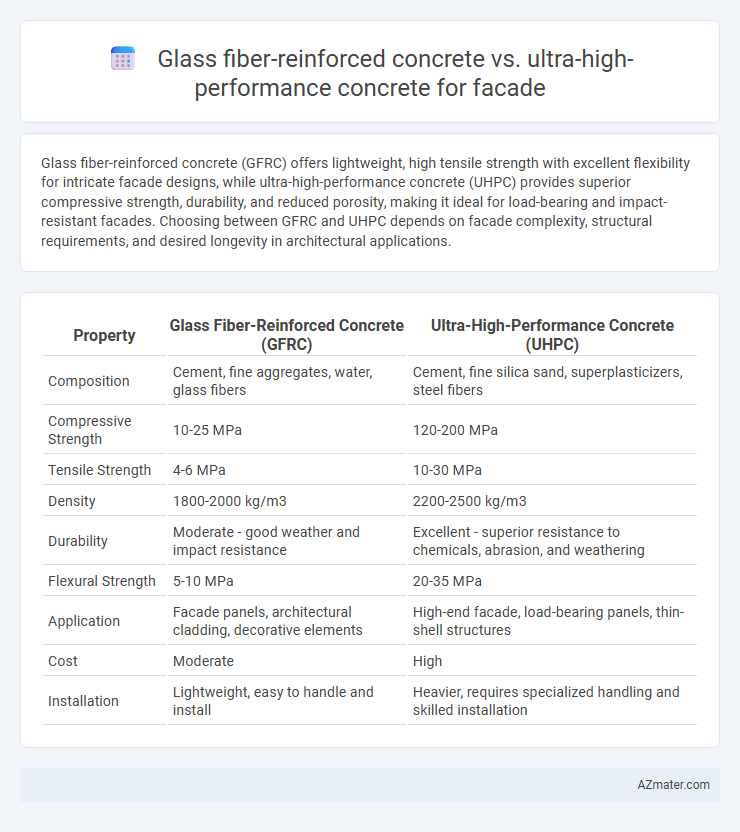Glass fiber-reinforced concrete (GFRC) offers lightweight, high tensile strength with excellent flexibility for intricate facade designs, while ultra-high-performance concrete (UHPC) provides superior compressive strength, durability, and reduced porosity, making it ideal for load-bearing and impact-resistant facades. Choosing between GFRC and UHPC depends on facade complexity, structural requirements, and desired longevity in architectural applications.
Table of Comparison
| Property | Glass Fiber-Reinforced Concrete (GFRC) | Ultra-High-Performance Concrete (UHPC) |
|---|---|---|
| Composition | Cement, fine aggregates, water, glass fibers | Cement, fine silica sand, superplasticizers, steel fibers |
| Compressive Strength | 10-25 MPa | 120-200 MPa |
| Tensile Strength | 4-6 MPa | 10-30 MPa |
| Density | 1800-2000 kg/m3 | 2200-2500 kg/m3 |
| Durability | Moderate - good weather and impact resistance | Excellent - superior resistance to chemicals, abrasion, and weathering |
| Flexural Strength | 5-10 MPa | 20-35 MPa |
| Application | Facade panels, architectural cladding, decorative elements | High-end facade, load-bearing panels, thin-shell structures |
| Cost | Moderate | High |
| Installation | Lightweight, easy to handle and install | Heavier, requires specialized handling and skilled installation |
Introduction to Modern Facade Materials
Glass fiber-reinforced concrete (GFRC) offers lightweight durability and high tensile strength, making it ideal for intricate facade designs and reducing structural load. Ultra-high-performance concrete (UHPC) delivers exceptional compressive strength, durability, and abrasion resistance, suitable for sleek, thin, and load-bearing facade panels. Both materials advance modern facades by combining aesthetic flexibility with enhanced structural performance and long-term resilience.
What is Glass Fiber-Reinforced Concrete (GFRC)?
Glass Fiber-Reinforced Concrete (GFRC) is a composite material consisting of a cementitious matrix reinforced with alkali-resistant glass fibers, enhancing its tensile strength and durability for facade applications. GFRC offers lightweight, high-strength panels that resist cracking, weathering, and corrosion, making it ideal for intricate architectural designs and thin, precast panels. Compared to Ultra-High-Performance Concrete (UHPC), GFRC provides greater flexibility in shaping complex facade elements while maintaining cost-efficiency and reduced installation weight.
Understanding Ultra-High-Performance Concrete (UHPC)
Ultra-High-Performance Concrete (UHPC) is a cementitious material characterized by its exceptional compressive strength, typically exceeding 150 MPa, combined with superior durability and enhanced tensile properties due to steel fiber reinforcement. UHPC's dense microstructure provides remarkable resistance to environmental degradation, making it ideal for facade applications requiring longevity and minimal maintenance. Compared to Glass Fiber-Reinforced Concrete (GFRC), UHPC offers higher mechanical performance and improved resistance to impact, abrasion, and freeze-thaw cycles, thereby supporting innovative architectural designs with thinner, lighter, and more resilient facade panels.
Strength and Durability: GFRC vs UHPC
Glass fiber-reinforced concrete (GFRC) offers high tensile strength and flexibility, making it resistant to cracking and suitable for intricate facade designs, while ultra-high-performance concrete (UHPC) excels in compressive strength, often exceeding 150 MPa, providing exceptional load-bearing capacity. UHPC exhibits superior durability due to its dense microstructure, low permeability, and enhanced resistance to environmental degradation, outperforming GFRC in resisting freeze-thaw cycles, chloride penetration, and abrasion. Both materials contribute to long-lasting facades, but UHPC's advanced mechanical properties ensure greater longevity and minimal maintenance in harsh conditions.
Aesthetic Flexibility and Design Possibilities
Glass fiber-reinforced concrete (GFRC) offers exceptional aesthetic flexibility due to its ability to be molded into intricate shapes, textures, and thin profiles, making it ideal for detailed facade designs. Ultra-high-performance concrete (UHPC) provides superior strength and durability, allowing for minimalist, sleek facade elements with smooth finishes and slender structural components. Both materials enhance design possibilities, but GFRC excels in ornamental customization while UHPC emphasizes structural elegance and resilience.
Weight and Structural Implications on Facades
Glass fiber-reinforced concrete (GFRC) offers a lightweight alternative to ultra-high-performance concrete (UHPC), significantly reducing the dead load on building facades and enabling easier installation and design flexibility. UHPC provides superior compressive strength and durability but is heavier, potentially necessitating stronger structural supports and increasing foundational costs. Selecting GFRC for facades can optimize weight management while maintaining adequate structural performance for non-load-bearing exterior cladding applications.
Installation and Construction Processes
Glass fiber-reinforced concrete (GFRC) offers lightweight panels that simplify handling and reduce installation time, requiring less structural support compared to ultra-high-performance concrete (UHPC), which demands more intricate formwork and curing procedures due to its high density and strength. GFRC facilitates faster on-site assembly with prefabricated elements, enabling quicker facade installation, whereas UHPC requires precise casting and extended curing periods to achieve optimal durability and load-bearing capacity. Both materials enhance facade performance, but GFRC's ease of installation and reduced construction complexity make it favorable for projects prioritizing speed and flexibility.
Cost Comparison: GFRC vs UHPC
Glass fiber-reinforced concrete (GFRC) offers a more cost-effective solution for facade applications compared to ultra-high-performance concrete (UHPC), with GFRC typically costing 30-50% less per square foot due to lower material and manufacturing expenses. UHPC, while providing superior durability and compressive strength exceeding 150 MPa, requires specialized materials like fine quartz sand and high cement content, driving initial costs significantly higher. The overall life cycle cost of GFRC benefits from reduced fabrication complexity, making it favorable for budget-sensitive facade projects without compromising aesthetic versatility.
Sustainability and Environmental Impact
Glass fiber-reinforced concrete (GFRC) offers enhanced sustainability through lightweight panels that reduce transportation emissions and require less raw material compared to ultra-high-performance concrete (UHPC). UHPC, while exhibiting superior strength and durability, typically involves higher cement content, leading to greater carbon emissions during production. Selecting GFRC for facades can significantly lower environmental impact by promoting resource efficiency and enabling easier recycling at the end of its lifecycle.
Choosing the Right Material for Your Facade Project
Glass fiber-reinforced concrete (GFRC) offers lightweight, flexible panels ideal for intricate facade designs, providing excellent tensile strength and resistance to cracking. Ultra-high-performance concrete (UHPC) delivers superior compressive strength, durability, and a sleek, dense surface suitable for high-impact, long-lasting facades in harsh environments. Selecting GFRC or UHPC depends on project requirements such as weight constraints, design complexity, environmental exposure, and budget considerations.

Infographic: Glass fiber-reinforced concrete vs Ultra-high-performance concrete for Facade
 azmater.com
azmater.com